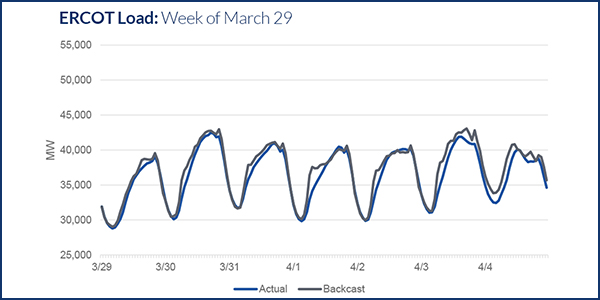By Tom Kleckner
While the COVID-19 pandemic has dampened industrial output and electricity load in much of the nation, ERCOT continues to set the pace for increases in demand.
The Texas grid operator, which has enjoyed fairly consistent 2% load growth in recent years, registered a new demand record for April when the system peaked at 55,180 MW on Wednesday during the hour ending at 5 p.m. CT. The preliminary operational data broke the previous mark of 53,846 MW, set in April 2017.
An ERCOT spokesperson attributed the record to the state’s higher-than-normal temperatures that pushed up demand during the day.
According to the National Weather Service, temperatures in the Dallas/Fort Worth Metroplex hit 97 degrees Fahrenheit on April 8, setting a daily record high. The low temperature of 71 F set a record for the highest minimum temperature for the date.
The monthly record was the first of 2020 after ERCOT set nine during the past two years. March’s peak demand of 52,819 MW was down 13.1% from last year’s March high of 60,756 MW.
The peak came as the nation’s electricity demand plunged to a 16-year low during the first week of the month. The Edison Electric Institute and energy traders cited closed offices, reduced industrial activity and mild weather for slowing demand.
The U.S. Energy Information Administration expects total U.S. power consumption to decline by 3% in 2020. (See related story, EIA: Renewable Capacity to Grow in 2020.)
ERCOT began monitoring the pandemic’s effect on load patterns in early March. Last week, the grid operator began providing weekly updates on the patterns on its Trending Topics webpage (under Presentations & Other).
It said there has been little effect on its daily peaks but that morning loads are 6 to 10% lower than what the forecast model would typically predict. (See “Texas Grid’s Weekly Energy Usage Down 2% in March,” ERCOT Technical Advisory Committee Briefs: April 1, 2020.)
“The overall load reduction for the ERCOT region has leveled off over the past two weeks,” said Calvin Opheim, ERCOT manager of load forecasting and analysis. He said energy usage was down about 2% for the weeks of March 22 and 29.
ERCOT staff are using a backcast model in their analysis, comparing model results using actual weather versus actual hourly load. The difference between what actually occurs and what the model shows is referred to as a “model error.” The model was last updated in January and does not reflect the pandemic’s effect, making it a “pure model” for analyzing the difference between the model and actual outcomes. The pandemic is a component of the model error.
Before the pandemic, ERCOT had projected a record summer peak demand of more than 76,600 MW, a 3,500-MW increase over last year. It will release a final forecast in May. (See ERCOT Sees Summer Repeat: Record Peak, Tight Reserves.)




